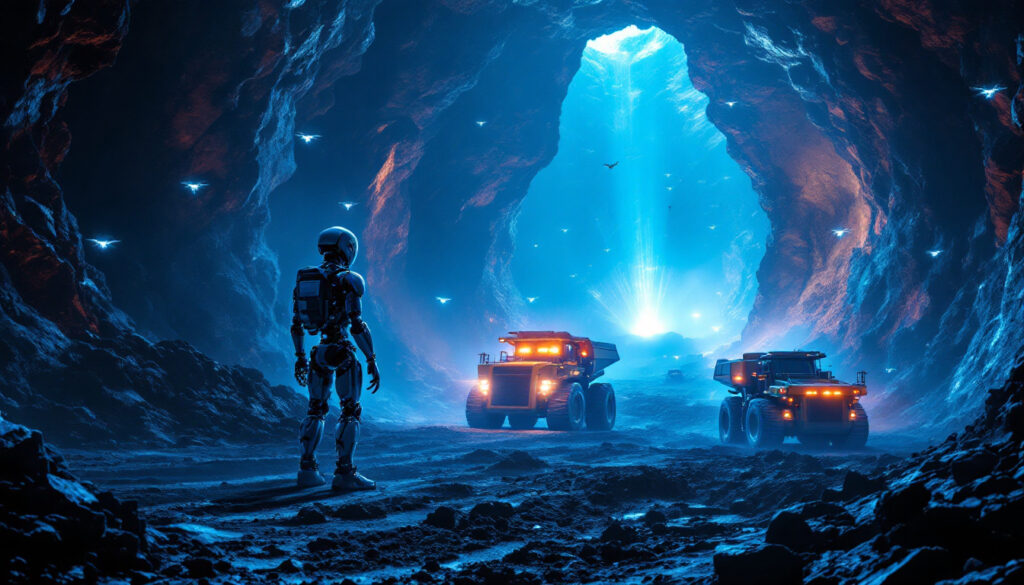How Has Automation Transformed the Mining Industry Over the Past 50 Years?
From Manual Operations to Technological Innovation
Fifty years ago, Australian mining relied heavily on manual labor, with operations centered on gold in Western Australia, lead and zinc at Broken Hill, and copper in Queensland. Equipment was rudimentary, requiring significant human intervention for tasks such as ore extraction and transport. The transition from pit ponies to automated longwall systems marked the early stages of technological integration, enabling safer and more efficient operations.
By the late 20th century, the industry shifted toward large-scale projects, particularly in iron ore and coal, driven by the need to meet global resource demands. This transition fundamentally changed how mining companies approached extraction, processing, and transportation of minerals, setting the stage for today's highly automated operations.
Key Technological Milestones
The adoption of autonomous haulage systems (AHS) in open-pit mines, pioneered by companies like Rio Tinto and Codelco, revolutionized material transport. These driverless trucks improved productivity by operating continuously without fatigue, reducing labor costs and enhancing safety. The implementation marked a turning point in mining operations globally.
Automated drilling rigs and real-time analytics further optimized resource extraction, enabling precise blasting and ore grading. Remote operations centers allowed engineers to monitor and control equipment from hundreds of kilometers away, drastically improving safety conditions for workers who previously needed to be physically present in hazardous environments.
These innovations collectively reduced operational risks and increased output, setting the stage for modern mining practices that leverage automation and technology in the mining industry to improve efficiency, safety, and environmental management.
Economic Impact of Mining Technology
Mining contributes over 10% to Australia's GDP, with the Mining Equipment, Technology, and Services (METS) sector adding an additional 160 billion AUD annually. Together, these sectors represent approximately 12% of the nation's economic output, underscoring their significance to Australia's prosperity and global standing.
The integration of automation has also mitigated labor shortages in remote regions, ensuring consistent production despite fluctuating workforce availability. This has been particularly important in Western Australia's Pilbara region, where finding and retaining skilled workers has traditionally been challenging due to extreme conditions and isolation.
What Does the Future of Mining Automation Look Like?
Underground Mining Automation
As surface mineral deposits become depleted, the industry is shifting focus to deeper underground reserves, where automation is critical for safe and efficient operations. Autonomous loaders and rock-breaking systems are increasingly deployed in deep mines, such as Chile's El Teniente and Chuquicamata, where rock temperatures exceed 60°C and seismic activity poses risks.
These systems minimize human exposure to hazardous environments while maintaining high productivity levels. Underground automation represents the next frontier in digital transformation in mining, with adoption rates accelerating as companies seek to access deeper ore bodies that were previously considered inaccessible or economically unviable.
The transition to underground operations presents unique challenges that surface mining doesn't face, including ventilation, ground support, and emergency response planning, all of which benefit from automated monitoring and control systems.
Robotic Systems and Humanoid Robots
Humanoid robots, adapted from military and security applications, are expected to perform manual interventions in underground mines within the next decade. Companies like Boston Dynamics are developing robots capable of bolting, debris removal, and ventilation management, tasks traditionally requiring human workers.
Such technologies promise to reduce injury rates and enable continuous operations in challenging conditions. The development of these robotic systems represents a significant leap forward from current automation technologies, which typically focus on specific, repetitive tasks rather than complex interventions that require human-like dexterity and decision-making.
The pace of innovation in this space has accelerated dramatically, with technologies that once seemed decades away now on the verge of commercial deployment in mining operations around the world.
In-Situ Mining Technologies
In-situ leaching, a method long used in uranium extraction, is being adapted for copper mining to minimize environmental disruption. By injecting solutions into ore bodies and extracting dissolved metals, companies like those in South Australia eliminate the need for traditional excavation, reducing surface footprint and energy consumption.
This approach is particularly advantageous for low-grade deposits, offering a sustainable alternative to conventional methods. In-situ techniques can access ore bodies that would be uneconomical to mine using traditional methods, potentially expanding recoverable reserves significantly while reducing environmental impact.
The technology also shows promise for extracting critical minerals needed for renewable energy technologies, addressing both environmental concerns and supply chain challenges for materials essential to the clean energy transition.
How Is AI Transforming Mining Operations?
Rapid Adoption of AI Solutions
At recent industry events, 30% of presenting METS companies showcased AI-driven solutions, a significant increase from previous years. AI applications now optimize processing circuits, predict equipment failures, and enhance ore recovery rates. For instance, Rio Tinto's AI-powered sorting systems have improved copper recovery from 93% to over 98%, reducing waste and energy use.
The speed of AI-driven exploration has surprised even industry veterans, with technologies moving from conceptual to operational in timeframes measured in months rather than years. This accelerated innovation cycle is transforming how mining companies approach problem-solving and operational optimization.
Machine learning algorithms can now process vast amounts of geological data to identify patterns invisible to human analysts, helping companies target exploration efforts more precisely and reduce the environmental footprint of their activities.
Data Analytics Applications
Despite progress, the mining sector lags in adopting real-time data analytics compared to other industries. While leading operations analyze data every few seconds, others still rely on monthly reports, missing opportunities for process optimization. Advanced analytics enable predictive maintenance, reducing downtime and extending machinery lifespan.
The gap between industry leaders and followers in data utilization represents one of the most significant competitive differentiators in modern mining. Companies that effectively leverage their operational data can achieve productivity improvements of 10-15% across their value chain, translating to hundreds of millions in additional revenue or cost savings.
The most advanced operations now employ digital twins in mining to simulate changes and optimize performance before implementing modifications in the real world, further enhancing efficiency and reducing risk.
Automation Control Centers
Remote operation centers, such as Rio Tinto's facility at Perth Airport, allow centralized control of multiple mine sites. These hubs integrate data from autonomous trucks, drills, and sensors, providing a holistic view of operations. Smaller miners are now adopting similar systems, leveraging Australian METS expertise to compete globally.
These centers represent a fundamental shift in how mining operations are managed, creating environments where specialists can collaborate across disciplines to optimize entire production systems rather than individual components. The transition from site-based to centralized control also improves work-life balance for employees, helping companies attract and retain talent that might otherwise avoid remote postings.
The technology ecosystem supporting these control centers continues to evolve, with enhanced visualization tools, AI-assisted decision support, and improved communication systems making remote operation increasingly effective and reliable.
What Mining Processes Are Being Revolutionized by Technology?
Processing Innovations
Bioleaching technologies, utilizing naturally occurring microbes, have enhanced metal recovery rates while reducing chemical use. Microwave-induced rock fracturing has lowered grinding energy requirements by 20–30%, offering cost and emissions savings. Automated gold assays, replacing traditional fire assays, now deliver results in minutes rather than days, accelerating decision-making.
These processing innovations address one of mining's most significant challenges: efficiently extracting valuable minerals from increasingly complex and lower-grade ores. By reducing energy requirements and chemical consumption, these technologies also help companies meet sustainability commitments while improving profitability.
The development of portable, rapid analysis equipment has also transformed quality control processes, allowing real-time adjustments to processing parameters based on ore composition variations, rather than discovering quality issues after material has already been processed.
Advanced Drilling and Cutting Technologies
Directional longhole drilling mitigates rock bursts in deep mines by relieving geological stress ahead of excavation. Electromagnetic rock-breaking systems, tested in Chilean copper mines, eliminate the need for explosives, reducing fumes and enabling continuous mining. These innovations address safety and efficiency challenges in hard-rock environments.
Next-generation drilling technologies now incorporate sensors that analyze rock properties as they penetrate, providing valuable geological information that would previously require separate core sampling and analysis. This integration of drilling and analysis functions significantly reduces development timeframes and improves resource characterization.
Non-explosive rock breaking methods not only improve safety by eliminating blast-related hazards but also enable more precise excavation, reducing overbreak and minimizing the amount of waste material that must be transported and processed.
Autonomous Fleet Operations
Autonomous trucks and drills dominate modern open-pit mines, operating with precision unmatched by human drivers. In Pilbara iron ore mines, these systems have reduced haulage costs by 15–20%, translating to annual savings of millions. Remote-controlled loaders and drills further enhance productivity in underground settings.
The implementation of AI-powered fleet management has expanded beyond individual vehicles to encompass entire integrated transportation systems, with trucks, trains, and port operations working in concert through sophisticated traffic management and optimization algorithms. This system-wide approach maximizes throughput and minimizes delays across the entire supply chain.
As autonomous technology advances, the distinction between surface and underground fleet management is blurring, with lessons learned in open-pit environments being successfully adapted to the more challenging conditions found underground.
What Challenges Face Mining Technology Adoption?
Industry Conservatism
Mining companies often prefer proven technologies, adopting innovations only after competitors demonstrate success. This "first to be second" mindset delays the implementation of advancements like AI and real-time analytics, stifling progress.
The risk-averse nature of the industry stems partly from the high costs of production disruptions, which can amount to millions of dollars per day at large operations. This creates a challenging environment for technology providers seeking to introduce novel solutions, as mining companies typically require extensive proof of concept before committing to full-scale implementation.
Changing this cultural resistance to innovation requires both technical demonstrations and organizational change management, addressing not just the technology itself but also the human factors that influence adoption decisions.
Capital Market Limitations
Junior miners face difficulty securing funding for non-traditional projects, particularly in critical minerals outside gold and copper. Investors' limited understanding of METS innovations exacerbates funding gaps, though specialized funds are emerging to bridge this divide.
The capital-intensive nature of mining, combined with commodity price volatility, creates additional barriers to technology investment, especially for smaller operators. While major miners can self-fund innovation, junior companies often struggle to allocate resources to technologies that may not deliver immediate returns despite their long-term potential.
Recent geopolitical emphasis on securing critical mineral supply chains is gradually changing this dynamic, with increased government support and strategic investment in technologies that enhance domestic production capabilities for materials deemed essential to national security.
Talent and Workforce Concerns
Declining enrollment in mining engineering programs threatens future expertise, as universities like Wollongong close their mining schools. Meanwhile, the shift toward data science and robotics requires reskilling existing workers, a transition many companies struggle to manage.
The industry faces a generational challenge, with experienced professionals approaching retirement while fewer young people choose mining careers. This demographic shift coincides with the evolution toward more technology-intensive operations requiring different skill sets than traditional mining roles.
Forward-thinking companies are addressing this challenge through partnerships with educational institutions, internal training programs, and recruitment strategies that highlight the high-tech nature of modern mining to attract talent that might otherwise gravitate toward other industries.
How Is China Influencing Mining Technology Development?
Chinese Technological Advancement
China has rapidly closed the technological gap, developing autonomous systems and humanoid robots for mining applications. Chinese-made equipment now appears in South American and Australian mines, competing with traditional Western suppliers.
The pace of China's advancement in automation and technology in the mining industry has surprised industry observers, with Chinese manufacturers moving from producing simple components to developing sophisticated integrated systems in less than a decade. This rapid progress has been enabled by significant government investment and strategic acquisition of foreign expertise.
Chinese innovations in areas like battery minerals processing and rare earth element separation have established new benchmarks for efficiency and cost-effectiveness, forcing Western companies to accelerate their own development programs to remain competitive.
Competitive Advantages
Lower labor costs and state-backed R&D enable Chinese firms to prioritize technological solutions over workforce expansion. Focused on copper and rare earths, China's innovations support its dominance in global electrification supply chains.
China's approach to mining technology development differs fundamentally from Western models, with greater emphasis on long-term strategic positioning rather than quarterly financial performance. This allows Chinese companies to make investments with longer payback periods, particularly in technologies that secure access to minerals critical for manufacturing and renewable energy.
The integration of mining technology development with downstream manufacturing creates additional advantages, as innovations can be designed specifically to enhance the quality and consistency of mineral inputs for high-value products like electric vehicles and electronics.
What Role Does Australia Play in Global Mining Innovation?
Australia's Unique Position
Australia's METS sector, valued at 160 billion AUD, collaborates closely with global miners to solve technical challenges. The CSIRO's mineral research group licenses technologies worldwide, including bioleaching and automated assays.
Australia's position as both a major mining nation and a technology developer creates unique advantages, with innovations tested and refined in domestic operations before being exported globally. This "living laboratory" approach accelerates development cycles and builds credibility for Australian solutions in international markets.
The country's mining technology ecosystem encompasses everything from university research centers to specialized startups and established global providers, creating a density of expertise unmatched elsewhere in the world and facilitating knowledge transfer across companies and projects.
Collaborative Innovation Models
Partnerships between miners and METS providers, such as Rio Tinto and Codelco's autonomous fleet venture, exemplify Australia's collaborative approach. These initiatives foster cross-border knowledge transfer, particularly in Chile and Canada.
The Australian model of collaboration extends beyond individual companies to include industry associations, government research organizations, and universities, creating a supportive environment for Mining 4.0 innovations that addresses common challenges. This ecosystem approach has proven particularly effective for complex problems requiring multidisciplinary solutions.
Australian innovation clusters in Perth, Brisbane, and Adelaide have become global hubs for mining technology development, attracting international investment and talent while exporting solutions to mining regions worldwide.
FAQ: Mining Technology and Automation
What is the timeline for fully autonomous underground mines?
Experts predict significant automation by 2035, with humanoid robots handling manual tasks. The development pathway will likely see incremental implementation of autonomous systems for specific functions, gradually expanding to encompass entire mining operations as technologies mature and integration challenges are resolved.
How does automation affect mining employment?
While automation reduces roles like truck drivers, it creates demand for data scientists and robotics engineers. The transition is reshaping workforce requirements from physical labor toward technical expertise, with implications for training programs and recruitment strategies. Mining regions are adapting by developing technology hubs and educational initiatives to prepare workers for these evolving roles.
What technologies enable environmentally friendly mining?
In-situ leaching and bioleaching minimize land disturbance and chemical use, aligning with sustainability goals. Additionally, precision blasting, water recycling systems, and renewable energy integration are reducing mining's environmental footprint. These technologies are becoming increasingly important as regulatory requirements tighten and consumers demand responsibly sourced materials.
How is AI currently applied in mining?
AI optimizes processing, predicts equipment failures, and enhances ore sorting, with 30% of METS firms now offering AI solutions. Machine learning algorithms analyze sensor data from equipment to predict maintenance needs before failures occur, while computer vision systems inspect conveyor belts and structures to identify potential issues. In exploration, AI helps identify promising drill targets by analyzing geological data patterns too complex for human interpretation.
"In 10–15 years, machines will autonomously operate underground, with robots handling manual interventions—this evolution will be faster than ever before." — Alan Broom.
Ready to Stay Ahead of Major Mining Industry Transformations?
Stay informed about groundbreaking mining innovations and investment opportunities with Discovery Alert's proprietary Discovery IQ model, which delivers real-time alerts on significant ASX mining and technology advancements. Visit our discoveries page to see how early notification of major mineral discoveries can lead to exceptional investment returns.




